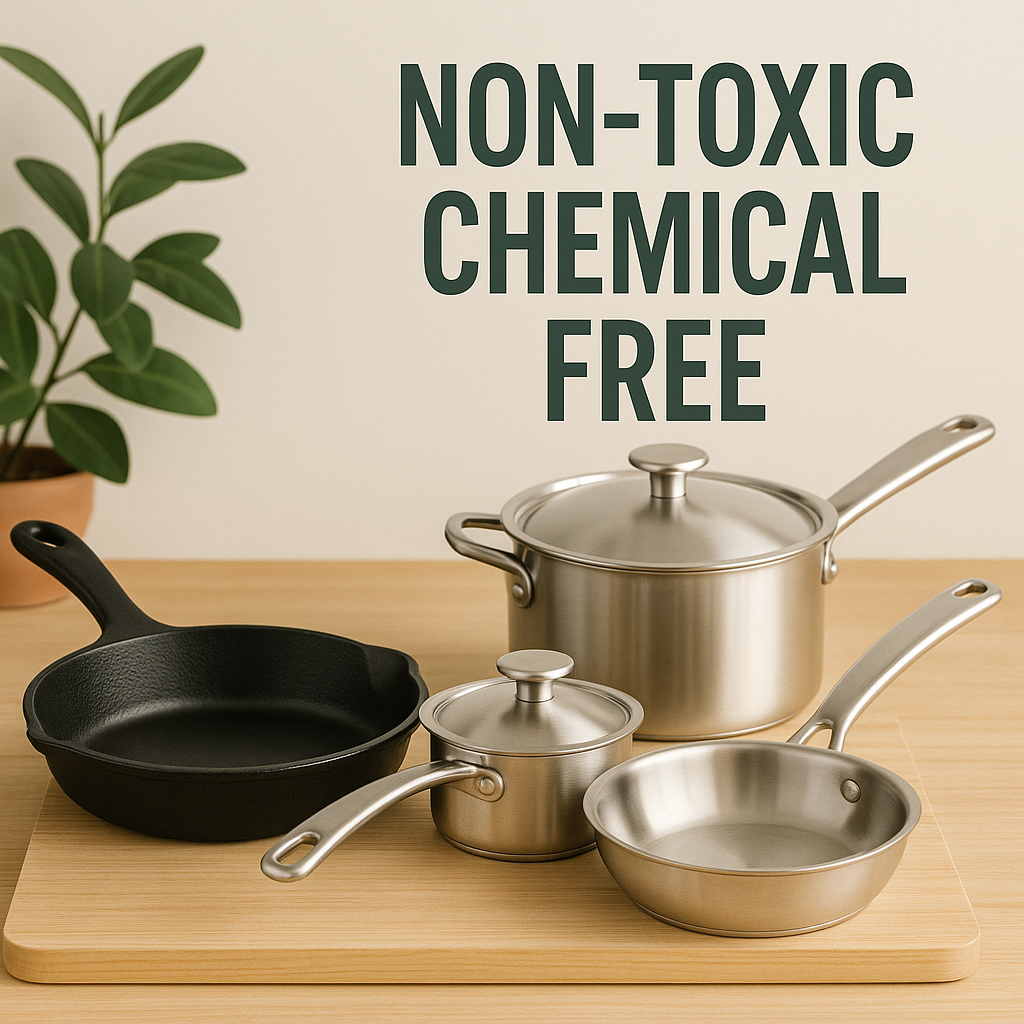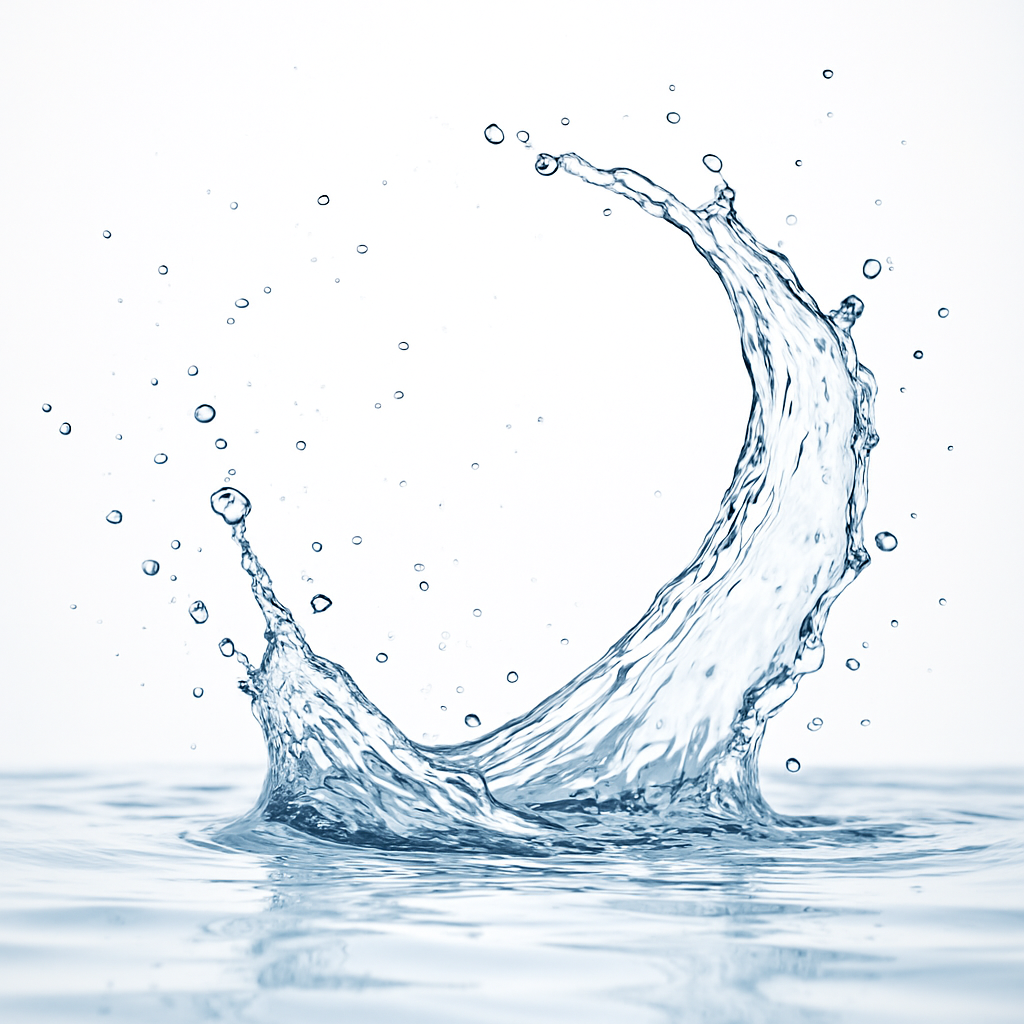Worried about those “forever chemicals” lurking in your kitchen? You’re not alone. PFAS (per- and polyfluoroalkyl substances) found in conventional nonstick cookware and pans have been linked to various health and environmental problems, making the search for non-toxic alternatives more important than ever.

If you’re like us, we didn’t know better than what we grew up on. Non stick pans were great, my eggs came out perfect every time! However, as you may have read from any of our other articles, once we started finding out about PFA’s we had to change immediately! And there are so many great choices! Whether it’s trusty cast iron, sleek stainless steel, or even lovely glass and ceramic-coated pans, there are plenty of ways to make sure harmful chemicals stay out of your meals, all while enjoying the joy of cooking!
We hope this article is useful in dissecting the what and why of forever chemicals and how easy it is do ‘low tox‘ or ‘non-toxic’. It might be a smaller step on it’s own but it’s another way of removing risk of exposure.
Understanding Forever Chemicals in Cookware
Forever chemicals lurk in many conventional nonstick pans, posing health risks that persist long after cooking. These man-made compounds don’t break down naturally in the environment and can accumulate in our bodies over time, making them a serious concern for health-conscious home cooks.
What Are PFAS, PTFE, and PFOA?
PFAS (per- and polyfluoroalkyl substances) encompass a massive class of over 12,000 man-made chemicals used for their nonstick, stain-resistant, and waterproof properties. PTFE, GenX, PFOA, and PFOS all belong to the PFAS family. When people mention “toxic cookware”, they’re typically referring to pans with nonstick coatings containing these chemicals. PTFE is commonly used in conventional nonstick pans, while manufacturers often advertise products as “PFOA-free“ despite containing other PFAS chemicals. It’s important to note that “free” labels can be misleading—companies can declare items PFOA-free even when they contain other forever chemicals or when PFAS levels fall below certain thresholds.
Health Concerns Associated with Forever Chemicals
The health risks of forever chemicals aren’t just hype—they’re backed by scientific evidence. PFAS earn their “forever” nickname because they don’t break down in the environment and accumulate in human blood and organs. Eating food cooked in PFAS-containing kitchenware increases exposure to these toxins. Studies link these chemicals to several serious health issues:
- Abnormal thyroid and hormone function
- Weakened immune system response
- Various cancers (kidney, liver, pancreatic, prostate, and testicular)
- Infertility and reproductive problems
- Liver damage
- Ulcerative colitis
EWG Senior Scientist Tasha Stoiber emphasizes the health concerns associated with these non-toxic alternatives becoming increasingly important for those seeking to detox their kitchens. Here’s a great article in Yahoo talking about forever chemicals. While many products claim to be “PFOA-free,“ they often contain PTFE or other PFAS, making truly organic and chemical-free options crucial for health-conscious consumers. Fortunately, safer alternatives like stainless steel, cast iron, carbon steel, and properly made ceramic cookware provide effective cooking solutions without the toxic burden.
Types of Forever Chemical Free Cookware
Safe, non-toxic cookware options exist in multiple materials that don’t contain harmful PFAS chemicals. These alternatives are equally as good as non-stick pans while keeping your food free from potentially dangerous substances that can leach into your food.
Ceramic and Ceramic-Coated Options
Pure ceramic cookware ranks among the safest cooking materials available, containing no heavy metals or toxic chemicals. It’s perfect for low and slow cooking techniques and transitions seamlessly from stovetop to oven. Ceramic conducts and retains heat exceptionally well while providing a naturally non-stick surface without the need for chemical coatings. When properly cared for, ceramic pans last several years and offer a more environmentally friendly manufacturing process compared to traditional non-stick options.
Ceramic-coated cookware provides another non-toxic alternative to PFAS-laden pans. These pots and pans feature a base material (typically aluminum) coated with a ceramic finish that creates a non-stick surface without forever chemicals. Though ceramic coatings generally have shorter lifespans than other materials, many brands now offer durable options that resist chipping and wear. When shopping for ceramic-coated options, look for products explicitly labeled “PFAS-free“ to ensure you’re getting a truly non-toxic choice.
Stainless Steel Cookware
Stainless steel pans offer worry-free cooking with outstanding durability and versatility. This material contains no harmful chemicals and won’t leach toxins into food. Professional chefs often prefer stainless steel for its heat distribution and ability to create perfect sears on proteins. Though not naturally non-stick, proper preheating (this is crucial, you have no idea how many eggs I’ve wasted by not preheating correctly!) and using butter or oil dramatically reduces sticking issues. Quality stainless steel cookware often features an aluminum or copper core sandwiched between stainless layers, providing superior heat conduction while maintaining a non-reactive cooking surface. For kitchens focused on organic cooking and detoxing from chemical exposure, stainless steel represents a reliable investment that lasts decades with proper care.
Cast Iron and Enameled Cast Iron
Cast iron cookware delivers exceptional performance while remaining completely free of forever chemicals. These pans develop a natural non-stick surface through proper seasoning—the process of baking oil into the pan’s surface. Cast iron excels at heat retention and creates perfect searing, baking, and slow-cooking results. The material actually adds beneficial iron to food, especially when cooking acidic ingredients. Well-maintained cast iron pans become family heirlooms, often lasting generations.
Enameled cast iron combines cast iron’s excellent heating properties with a glass-based enamel coating that prevents rusting and eliminates the need for seasoning. This non-toxic alternative works beautifully for everything from searing to baking to simmering. The enamel surface prevents food from directly contacting metal, making it ideal for cooking acidic foods that might react with traditional cast iron. High-quality enameled cast iron from reputable manufacturers uses lead-free coatings that won’t leach chemicals into food.
Carbon Steel Alternatives
Carbon steel pans offer the perfect middle ground between cast iron and stainless steel—lighter than cast iron but with similar heat retention and natural non-stick properties when properly seasoned. Professional chefs particularly value carbon steel for its heat control and ability to develop a beautiful patina over time. The material contains no chemical coatings or PFAS compounds, making it a choice for health-conscious cooks. Carbon steel woks, frying pans, and paella pans perform really well at high heat, creating the perfect sear on meats and vegetables. Like cast iron, carbon steel requires proper seasoning and maintenance, but rewards users with a naturally non-stick cooking surface that improves with use.
Evaluating Non-Toxic Cookware Claims
Navigating through cookware marketing claims can be overwhelming when seeking truly non-toxic options. Manufacturers often use buzzwords that sound impressive but don’t necessarily guarantee safety. Here’s how to cut through the noise and identify genuinely safe cookware.
Certification and Testing Standards
Third-party certifications provide valuable assurance when evaluating non-toxic cookware. Look for products tested by organizations like NSF International, which verifies material safety and performance. The Prop 65 compliance label indicates the cookware meets California’s strict standards for potentially harmful chemicals. For ceramic cookware, FDA ceramic safety standards certification ensures the absence of heavy metals like lead and cadmium in the coating.
Many manufacturers claim their products are “detoxing” or “organic,“ but these terms aren’t regulated in cookware marketing. Instead, focus on certifications that verify testing for specific chemicals. Products certified by the Environmental Working Group (EWG) have undergone rigorous testing to ensure they’re free from harmful substances. When evaluating ceramic-coated options, products that meet European Union standards typically have stricter testing requirements than those following only U.S. regulations.
Testing standards vary widely between manufacturers. Some companies perform their own internal testing, while others use independent labs to verify their claims. We’ve found that reputable brands readily share their testing methodologies and results when asked, providing transparency about safety standards. The most reliable non-toxic cookware options undergo continuous testing throughout the manufacturing process, not just on final products.
Cooking Performance Considerations
Choosing non-toxic cookware doesn’t mean compromising on cooking performance. Each material offers unique performance characteristics that affect your cooking experience and food results. Here’s what you need to know about how different chemical-free cookware options perform in the kitchen.
Heat Conductivity and Retention
Different non-toxic cookware materials conduct and retain heat in distinct ways. Cast iron excels at heat retention, maintaining consistent temperatures once heated, making it perfect for searing meats and slow-cooking stews. Stainless steel heats quickly but doesn’t retain heat as well as cast iron. Pure ceramic cookware distributes heat evenly and retains it exceptionally well, ideal for low and slow cooking techniques. Carbon steel combines quick heating with good retention properties. Here’s a simple table to do a quick comparison.
Material |
Heat Conductivity |
Heat Retention |
Best For |
|---|---|---|---|
| Cast Iron | Moderate | Excellent | Searing, baking, slow cooking |
| Stainless Steel | Good | Fair | High-heat cooking, acidic foods |
| Ceramic | Even | Very Good | Low-heat cooking, braising |
| Carbon Steel | Good | Good | Stir-frying, sautéing |
Durability and Longevity
Non-toxic cookware typically offers impressive longevity compared to conventional non-stick options. Properly maintained cast iron pans, called seasoning, literally last generations and develop better non-stick properties over time. It can be a bit time consuming but is 100% worth it. Stainless steel ranks among the most durable cookware materials, resisting scratches, dents, and corrosion for decades. Carbon steel develops a natural patina that improves with use. Ceramic-coated cookware typically has a shorter lifespan (3-5 years) than other non-toxic options but still outlasts conventional non-stick pans when properly cared for.
Maintenance Requirements
Each non-toxic cookware type comes with specific maintenance needs. Cast iron requires regular seasoning—applying thin layers of oil and heating—to maintain its natural non-stick surface and prevent rust. Carbon steel shares similar seasoning requirements but is typically lighter and easier to maneuver. Stainless steel doesn’t need seasoning but benefits from preheating and proper oil use to prevent food sticking. Pure ceramic cookware needs gentle handling to prevent chips or cracks but doesn’t require special treatments to maintain its non-stick properties.
Care Tips to Extend Lifespan
To maximize your non-toxic cookware investment, follow these material-specific care practices:
- Cast Iron: Never soak, wash with minimal soap if necessary, dry thoroughly, and apply a light oil coating after washing
- Stainless Steel: Preheat before adding oil and food, deglaze to release stuck bits, avoid abrasive cleaners on polished finishes
- Ceramic Cookware: Use wooden or silicone utensils to prevent scratching, allow to cool before washing to prevent thermal shock
- Carbon Steel: Clean while still warm, avoid prolonged exposure to acidic foods, maintain seasoning similar to cast iron
Conclusion
Making the switch to forever chemical-free cookware isn’t just a trend—it’s a meaningful step toward protecting our health and the environment. The good news is we don’t have to sacrifice cooking performance to avoid toxic substances.
For now, we’ve had a cast iron pan for a few years that we mainly cook our steaks, pork chops or any protein we use in the oven.
In addition, we’ve replaced all non-stick pans with Stainless Steel. Like I said earlier, it was a bit of a process to not have my eggs (or anything else) get stuck to my pan but I’ve finally figured it out. Pre-heating is everything!
Find other articles related to detoxing your kitchen on our kitchen specific page.
By learning to recognize truly non-toxic options and understanding third-party certifications we can all make better choices for our kitchens. Your future meals will taste better knowing they’re prepared on surfaces designed to keep your family safe for years to come.

